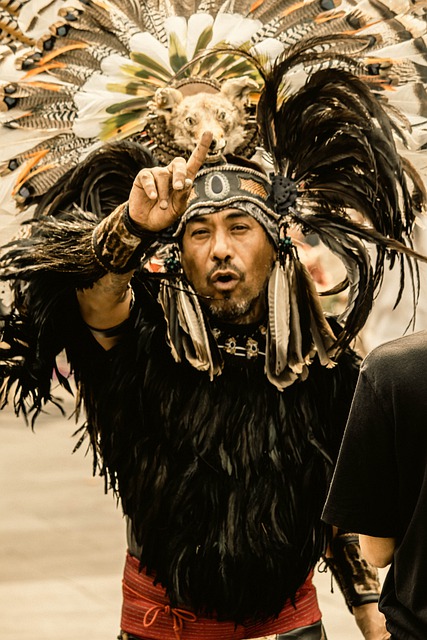 HL writes: “Can you please help me with information about Aztec dancing and whether it’s a concern. Our parish hosts a yearly feast of Our Lady of Guadalupe and our bishop comes every year to celebrate. Aztec dancers, some very immodestly dressed, would dance during the offertory and incense the image of Our Lady. I don’t feel that it’s appropriate that they participate at our Mass and I spoke to my pastor about it. Our pastor felt he needs more substantial information because the one that he sent me is in favor of the dancers. I personally don’t feel edified or pious when the Aztec dancers participate at mass because their dancing and music are distracting. Could you please help me with this? I have young and impressionable sons and I’m not sure I feel right having them see barely clothed people dancing in rather mesmerizing ways.”
HL writes: “Can you please help me with information about Aztec dancing and whether it’s a concern. Our parish hosts a yearly feast of Our Lady of Guadalupe and our bishop comes every year to celebrate. Aztec dancers, some very immodestly dressed, would dance during the offertory and incense the image of Our Lady. I don’t feel that it’s appropriate that they participate at our Mass and I spoke to my pastor about it. Our pastor felt he needs more substantial information because the one that he sent me is in favor of the dancers. I personally don’t feel edified or pious when the Aztec dancers participate at mass because their dancing and music are distracting. Could you please help me with this? I have young and impressionable sons and I’m not sure I feel right having them see barely clothed people dancing in rather mesmerizing ways.”For those who never heard of it, Aztec dancing is a form of dance specifically created to maintain the link of the Mexican people to their indigenous roots. It is performed by dancers who stomp their feet, which are usually wrapped with clusters of copper bells known as ayoyotes, and bedecked in feathers, all of which is meant to recall the music and culture of pre-hispanic Mexico.
The dance originated when the Franciscans Friars, known as the conquistadores, arrived centuries ago to bring Christianity to the nation. The Friars introduced musical instruments such as the conch, a kind of guitar/mandolin hybrid, to their traditional dances, which is why these dancers are also referred to as Concheros.
“It was only through these dances that the Aztecs were able to maintain some connection with the ancient occult practices, and the conquistadors couldn’t wrest these ‘prayers’ from their conquered subjects, as they had the sacrifices, most other singing and dancing, and multiple other everyday and ritualistic activities,” this site explains.
 Different cities have different versions of the dance and the accompanying instruments.
Different cities have different versions of the dance and the accompanying instruments.
“In Mexico City, you’re likely to find Conchero Dancers bedecked in ankle bells and with tall plumes of beautiful feathers and a few pieces of fabric with vivid figures and bright colors. Women frequently sportdresses with side slits (huipil) and chest, knee, and wrist bracelets and sometimes men are painted with the face or figure of a god or animal being honored.”
Anyone can participate in the dance, children and adults, young or old, “as long as they appreciate with due respect and understanding, the gravity of the dance, the point of which is to annul the forces of evil and disrespect for women, wildlife and humanity.”
Obviously, this dancing does not belong on the altar of Christ. As Jesse Romero, a Mexican American Catholic author and evangelist, says, this phenomenon of allowing Concheros to dance inside the Church only came about since the false ecumenism movement that followed Vatican II. The Catholics who are performing the dances may not be worshiping Aztec gods, but they are still improperly clinging to pagan religious practices.
“As Catholics we cannot mix our Catholic faith with the Aztec pagan religious practices, this is known as the sin of syncretism,” Romero writes. “Too many uncatechized Mexican Catholics are mixing Catholicism with paganism because they don't know their faith…If we are stuck in our pagan past, we can't grow up and follow the Gospel of Jesus Christ. All those traditions had some elements of truth, but now that we have found the fullness of truth in the Catholic religion, why should we revert to the past and dress like our pagan ancestors that hunted for their food, practiced infanticide, practiced cannibalism, made shrines out of decapitated skulls and worshipped false gods? Some people call this inculturation, I disagree, this is false ecumenism.”
As Romero correctly points out, every Caucasian Catholic is a descendant of a pagan, be they Vikings, Barbarians, Vandals, Visigoths or Pirates. “Do they come to Catholic Churches on designated days dressed like their pagan descendants and begin dancing in the courtyard in honor of their pagan deities? No.”
He believes it is condescending to look at Hispanic Catholics and allow them to continue to wallow in their ignorance. “That’s clericalism in my opinion,” he says. “It’s like saying: pobrecito (poor one), you’re too simple minded and/or ignorant to understand the Gospel of Jesus Christ, so continue to practice your Aztec paganism, muchachito (little child).”
Perhaps you should point out to your pastor the words of St. Paul in 2 Corinthians 6: 14-17 which certainly apply to this case: “Do not be yoked with those who are different, with unbelievers. For what partnership do righteousness and lawlessness have? Or what fellowship does light have with darkness? What accord has Christ with Beliar? Or what has a believer in common with an unbeliever? What agreement has the temple of God with idols? For we are the temple of the living God; as God said: ‘I will live with them and move among them, and I will be their God and they shall be my people.Therefore, come forth from them and be separate,’ says the Lord.”
© All Rights Reserved, Living His Life Abundantly®/Women of Grace® http://www.womenofgrace.com
